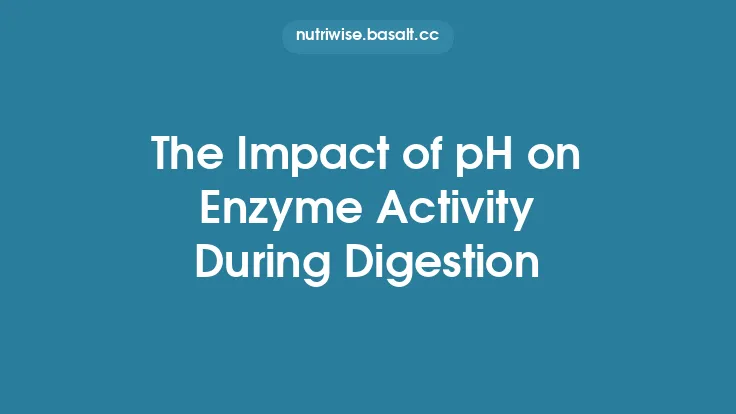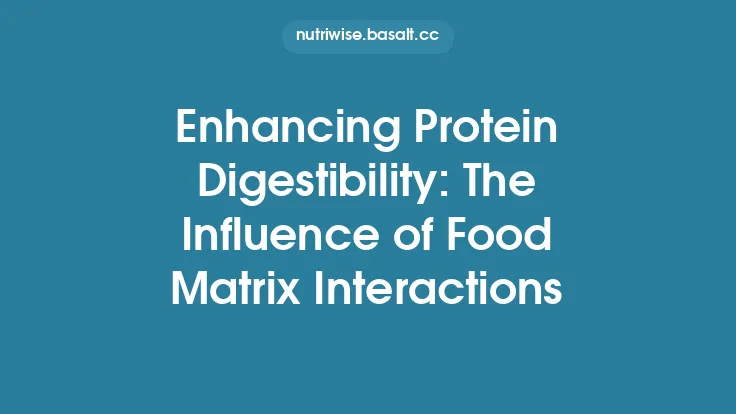The modern food supply relies heavily on a wide array of additives that serve to preserve freshness, improve texture, enhance flavor, and extend shelf life. While these substances are generally regarded as safe when used within regulatory limits, they do not remain inert as they travel through the gastrointestinal tract. Instead, many additives interact directly or indirectly with the enzymes that orchestrate the breakdown of macronutrients, thereby influencing the efficiency and pattern of digestion. Understanding these interactions is essential for nutrition scientists, food technologists, and health‑conscious consumers who wish to evaluate the true impact of processed foods on digestive health.
Common Categories of Food Additives and Their Functional Roles
| Additive Class | Typical Examples | Primary Technological Function |
|---|---|---|
| Preservatives | Sodium benzoate, potassium sorbate, nitrites, sulfites | Inhibit microbial growth and oxidative spoilage |
| Emulsifiers & Stabilizers | Lecithin, mono‑ and diglycerides, polysorbates, carrageenan, xanthan gum | Facilitate the formation and maintenance of oil‑in‑water or water‑in‑oil systems |
| Antioxidants | Ascorbic acid (E300), tocopherols (E306), BHA/BHT (E320/E321) | Prevent lipid oxidation and color degradation |
| Flavor Enhancers | Monosodium glutamate (MSG), nucleotides (IMP, GMP) | Amplify taste perception, especially umami |
| Colorants | Carotenoids (β‑carotene), anthocyanins, synthetic dyes (e.g., Tartrazine, E102) | Impart or restore visual appeal |
| Acidulants & pH Modifiers | Citric acid, phosphoric acid, lactic acid | Adjust acidity for taste, preservation, and texture |
| Thickeners & Gelling Agents | Pectin, agar, gelatin, modified starches | Modify viscosity and gel formation |
Each class possesses distinct physicochemical properties that can affect enzyme activity through mechanisms such as pH alteration, substrate accessibility, direct enzyme binding, or modulation of the gut microenvironment.
Mechanistic Pathways Linking Additives to Enzyme Activity
- pH Modulation
Many enzymes exhibit narrow optimal pH ranges (e.g., pepsin in the stomach at pH 1.5–2.5, pancreatic amylase in the duodenum at pH 6.7–7.0). Acidulants like citric or phosphoric acid can transiently lower luminal pH, potentially suppressing enzymes that are less acid‑tolerant while enhancing acid‑stable enzymes.
- Direct Enzyme Inhibition or Activation
Certain preservatives (e.g., sulfites) can bind to thiol groups in enzyme active sites, leading to reversible inhibition. Conversely, some emulsifiers may act as mild activators by stabilizing enzyme conformations or facilitating substrate emulsification.
- Alteration of Substrate Accessibility
Emulsifiers and thickeners can modify the physical state of macronutrients, creating micellar or gel matrices that either expose or shield substrates from enzymatic attack. For instance, polysorbate 80 can disperse lipid droplets, increasing the surface area available to pancreatic lipase.
- Interaction with the Mucosal Barrier
High concentrations of certain additives (e.g., carrageenan) have been shown to affect tight junction integrity, potentially altering the diffusion of digestive enzymes and their substrates across the mucosal layer.
- Microbiota‑Mediated Effects
Additives that escape upper‑gut digestion reach the colon, where they can be metabolized by resident microbes. Metabolites such as short‑chain fatty acids (SCFAs) can indirectly influence host enzyme expression and activity in the small intestine through signaling pathways.
Impact on Carbohydrate‑Digesting Enzymes
Salivary and Pancreatic Amylases
Emulsifiers that increase the dispersion of starch granules can enhance the accessibility of α‑amylase, leading to a faster initial rate of maltose production. However, certain preservatives (e.g., benzoates) have been reported to competitively inhibit amylase by binding to the enzyme’s calcium‑binding sites, reducing catalytic efficiency.
Disaccharidases (Maltase, Sucrase, Lactase)
Acidulants that lower duodenal pH may impair the optimal activity of brush‑border disaccharidases, which generally function best near neutral pH. This can result in delayed monosaccharide absorption and transient osmotic diarrhea in susceptible individuals.
Glycosidases from Gut Microbiota
Non‑digestible additives such as certain modified starches can serve as prebiotic substrates, stimulating microbial glycosidase production. The resulting increase in microbial carbohydrate breakdown can alter the profile of fermentable sugars reaching the colon, influencing overall carbohydrate metabolism.
Influence on Protein‑Digesting Enzymes
Pepsin and Gastric Proteases
Sulfite preservatives can react with the sulfhydryl groups of pepsin, leading to reversible inhibition. This effect is dose‑dependent and may be more pronounced in individuals with reduced gastric acid secretion.
Pancreatic Proteases (Trypsin, Chymotrypsin, Elastase)
Emulsifiers that improve the solubilization of protein aggregates can facilitate protease access, potentially enhancing protein hydrolysis. Conversely, high concentrations of certain polyphosphates used as acidity regulators can chelate calcium ions, which are essential cofactors for trypsin activation, thereby attenuating proteolysis.
Brush‑Border Peptidases
Additives that increase intestinal viscosity (e.g., xanthan gum) can slow the diffusion of peptide fragments to the epithelial surface, reducing the rate at which di‑ and tripeptides are cleaved into free amino acids.
Effects on Lipid‑Digesting Enzymes
Gastric Lipase
The presence of emulsifiers such as lecithin can mimic bile salts, promoting the formation of mixed micelles that are more readily acted upon by gastric lipase. However, synthetic surfactants (e.g., polysorbates) at supra‑regulatory levels may disrupt the interfacial layer required for optimal lipase binding, leading to reduced hydrolysis.
Pancreatic Lipase and Colipase Complex
Emulsifiers that generate stable oil‑in‑water emulsions increase the surface area for pancreatic lipase, often resulting in higher rates of triglyceride breakdown. Yet, certain antioxidants (e.g., BHA) have been shown in vitro to bind to the lipase active site, causing modest inhibition.
Bile Salt Interaction
Acidulants that lower intestinal pH can precipitate bile salts, diminishing their emulsifying capacity and indirectly reducing lipase efficiency. Conversely, some emulsifiers can act synergistically with bile salts, stabilizing micelles and facilitating lipid absorption.
Additive‑Induced Modulation of Gut Microbial Enzymes
A substantial proportion of ingested additives bypass upper‑gut digestion and become substrates for colonic microbes. The resulting enzymatic activities can have systemic repercussions:
- Sulfite‑Reducing Bacteria: Sulfite preservatives select for sulfite‑reducing bacterial populations, which produce hydrogen sulfide—a compound that can impair colonic epithelial cells and alter mucosal enzyme expression.
- Polysaccharide‑Degrading Microbes: Modified starches and certain gums act as fermentable fibers, stimulating microbial amylases and glucosidases, thereby increasing SCFA production. SCFAs, particularly butyrate, can up‑regulate host intestinal alkaline phosphatase, an enzyme involved in detoxifying bacterial lipopolysaccharide.
- Phenolic‑Degrading Species: Synthetic colorants may be metabolized by specific bacterial phenol‑oxidases, leading to the formation of metabolites that can either inhibit or stimulate host digestive enzymes through signaling pathways.
Regulatory Perspectives and Safety Assessments
Regulatory agencies (e.g., FDA, EFSA, JECFA) evaluate food additives primarily on toxicological grounds, establishing Acceptable Daily Intakes (ADIs). However, enzyme‑related effects are often considered secondary and are evaluated only when there is clear evidence of adverse digestive outcomes. Recent scientific advances have prompted calls for:
- Inclusion of Enzyme Interaction Endpoints in standard safety testing, such as measuring amylase or lipase activity in simulated gastrointestinal fluids.
- Post‑Market Surveillance focusing on gastrointestinal complaints linked to high‑additive diets, especially in vulnerable groups (e.g., infants, the elderly, individuals with pre‑existing digestive disorders).
- Re‑evaluation of Cumulative Exposure, recognizing that consumers may encounter multiple additives with overlapping mechanisms of enzyme modulation.
Practical Implications for Consumers and Food Manufacturers
For Consumers
- Read Labels Carefully: Identify additives known to affect enzyme activity (e.g., sulfites, high levels of emulsifiers) and consider limiting intake if you experience digestive discomfort.
- Balance Whole Foods and Processed Items: Incorporating fresh fruits, vegetables, and minimally processed proteins can offset potential inhibitory effects of additives.
- Mind the Timing: Consuming additive‑rich meals alongside enzyme‑rich foods (e.g., pineapple containing bromelain) may mitigate inhibition through competitive interactions.
For Food Manufacturers
- Select Additives Strategically: Opt for emulsifiers that enhance enzyme accessibility (e.g., lecithin) rather than those that may impede lipase activity.
- Optimize Concentrations: Use the minimal effective dose to achieve the desired technological effect, thereby reducing the likelihood of enzyme interference.
- Formulate with Enzyme‑Friendly Matrices: Incorporate natural substrates (e.g., fruit purees) that can act as protective carriers for sensitive enzymes during processing and storage.
Future Research Directions
- High‑Throughput In Vitro Digestion Models
Development of standardized simulated gastrointestinal systems that can simultaneously assess additive‑enzyme interactions across the entire digestive tract.
- Omics‑Based Approaches
Leveraging proteomics and metabolomics to map changes in host and microbial enzyme expression profiles following chronic exposure to specific additives.
- Personalized Nutrition Studies
Investigating how genetic polymorphisms in digestive enzymes (e.g., lactase persistence, amylase copy number variation) modulate individual susceptibility to additive‑induced effects.
- Longitudinal Cohort Analyses
Tracking dietary additive intake alongside biomarkers of digestive efficiency (e.g., fecal elastase, breath hydrogen) to establish causal relationships.
- Synergistic and Antagonistic Additive Networks
Exploring how combinations of additives (e.g., emulsifier + preservative) interact to produce additive or mitigating effects on enzyme activity.
In sum, food additives are far from passive ingredients; they can shape the digestive landscape by influencing the activity of key enzymes that break down carbohydrates, proteins, and lipids. While regulatory frameworks assure safety at the population level, nuanced interactions at the enzymatic level warrant continued scientific scrutiny. By integrating mechanistic insights with practical dietary guidance, both consumers and the food industry can make informed choices that support optimal digestion without compromising the functional benefits that additives provide.





